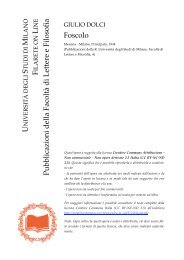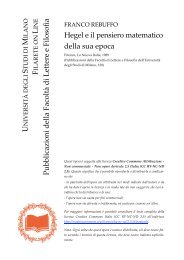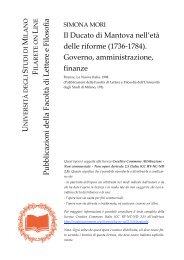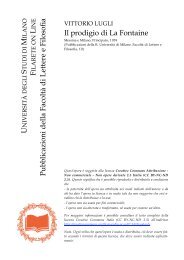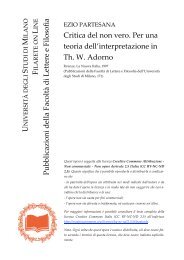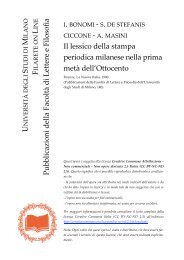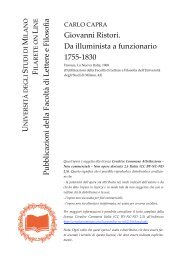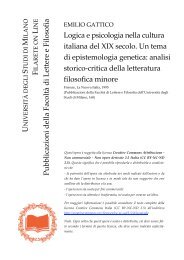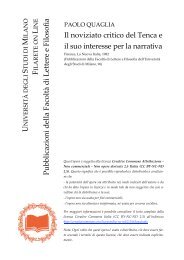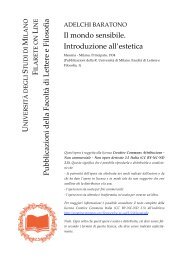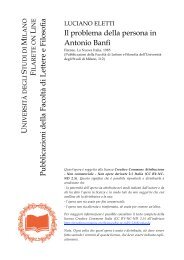U S M F L P u bblicazion i della Facoltà di Lettere e Filosofia La ...
U S M F L P u bblicazion i della Facoltà di Lettere e Filosofia La ...
U S M F L P u bblicazion i della Facoltà di Lettere e Filosofia La ...
You also want an ePaper? Increase the reach of your titles
YUMPU automatically turns print PDFs into web optimized ePapers that Google loves.
LE TEORIE CLASSICHE DEGLI STILI 37<br />
complessivamente rimanda al concetto <strong>di</strong> « mixture of styles », sono<br />
« either mixtures of ideas or ideas which mix with others ». Analoga<br />
<strong>di</strong>stinzione lo stu<strong>di</strong>oso propone per le sud<strong>di</strong>visioni del « mègethos »:<br />
semnòtes e peribolè « ' exist in their own ', thè others appear only in<br />
combination with other ideas » x.<br />
Per ciascuna <strong>di</strong> queste categorie si danno una definizione, una<br />
serie <strong>di</strong> esempi e soprattutto — come già si accennava — un elenco ra<br />
gionato <strong>di</strong> artifici retorici e grammaticali appropriati. È anche interes<br />
sante notare che tali artifici vengono classificati secondo uno schema <strong>di</strong><br />
otto « parti » — ènnoia, mèthodos, lèxis, schèmata, kòla, synthesis, anà-<br />
pausis e rhythmòs ** — che i trattatisti rinascimentali, che traducono o<br />
rielaborano Ermogene, riproducono costantemente, variandolo tuttavia,<br />
talora per omissione, talora per aggiunta <strong>di</strong> alcune parti, e mostrando<br />
una certa oscillazione nel tradurre i singoli termini 40 . Comunque, lo<br />
schema risulta sufficientemente chiaro e in definitiva ben assimilato da<br />
gli autori rinascimentali, anche perché propone, accostati e sistematiz<br />
zati, concetti e termini non nuovi alla tra<strong>di</strong>zione retorica.<br />
Complessivamente l'insieme delle quin<strong>di</strong>ci « ideai » e soprattutto<br />
delle otto parti costitutive <strong>di</strong> ciascuna, con tutte le in<strong>di</strong>cazioni analiti<br />
che ivi comprese, costituisce un sistema che, per quanto lo si possa oggi<br />
giu<strong>di</strong>care confuso e approssimativo, doveva certo rispondere bene al bi-<br />
38 Cfr. Kennedy 1983, pp. 97-98, dove fra l'altro si <strong>di</strong>ce: « As it happens, they<br />
[= thè ideas] are treated in groups which could be identified with thè plain, thè<br />
grand, thè middle, and a mixture of styles, but Hermogenes does not make this<br />
point and apparently thought that such categories, which remain basic in thè<br />
<strong>La</strong>titi tra<strong>di</strong>tion, were of little use in teaching composition ». <strong>La</strong> relazione fra<br />
« ideai » e « charactères » tri o quadripartiti rimane, dunque, puramente conget<br />
turale, vista l'assenza <strong>di</strong> in<strong>di</strong>cazioni esplicite in merito da parte del retore greco.<br />
Di qui l'assimilazione successiva tra idee ermogeniane e stili <strong>di</strong> <strong>di</strong>versa tra<strong>di</strong>zione.<br />
39 <strong>La</strong> Patterson (1970, p. 27) così lo descrive: « each Idea has a certain Sen-<br />
tence, or subject matter; Method, or principle of organizing that subject matter;<br />
Diction; Figures, or appropriate list of schemes and tropes; Members, or use of<br />
junctures to create phrases and periods of <strong>di</strong>fferent lenght; Composition, or tex-<br />
ture of vowels and consonants; Cadence; and Number, or rhythm generally ». Cfr.<br />
anche Kennedy 1983, pp. 97-98.<br />
40 Ad esempio, il Trapezuntius (1493, foglio n. iii verso) <strong>di</strong>stingue « senten-<br />
tia », « methodus vel artificium », « compositio », « <strong>di</strong>ctio », « exornatio », « mem-<br />
brum » e « numerus », <strong>di</strong>stinto in « collocatio » (cioè « <strong>di</strong>ctionum numerosa com<br />
positio ») e « clausola » (cioè « uniuscuiusque orationis aut etiam membri nume<br />
rosa depositio »); il Cavalcanti (1560, p. 330) <strong>di</strong>stingue «senso, o vero concetto,<br />
parole, compositione, membri, modo, figure, finimento, numero, o vero harmo-<br />
nia ». Il Barbaro (1557, p. 381) parla <strong>di</strong> « sentenza », « artificio », « parole e voci »,<br />
« figure », « membra », « composizione » e « chiusa o termine ».



